 klaus-michael schneider
klaus-michael schneider
Keywords: education |
Links: FOTW homepage | search | disclaimer and copyright | write us | mirrors

Last modified: 2021-08-26 by  klaus-michael schneider
klaus-michael schneider
Keywords: education |
Links: FOTW homepage |
search |
disclaimer and copyright |
write us |
mirrors
See also:
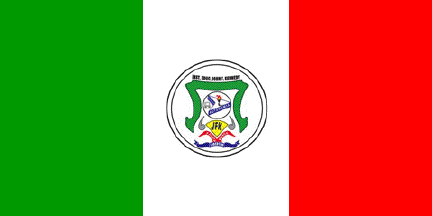 image by Ivan Sache, 12 August 2014
image by Ivan Sache, 12 August 2014
Institución Educativa John F. Kennedy was established in 1964 in Puerto
Boyacá (Boyacá Department), as Concentración Kennedy. This was part of the
Alliance of Progress, a joint educational program set up by Colombia and the
USA. The institutes established in the frame of the program were named for
President Kennedy. Resolutions No. 1,804 and 1,805 of 13 June 2000 transformed
the institute into Colegio de Educación Basica y Media Academica John F.
Kennedy. Institución Educativa John F. Kennedy was eventually established by
Resolution No. 367 of 20 February 2009.
The flag of the institute is vertically divided green-white-red with the
institute's emblem in the middle. Green is a symbol of ecology. White is a
symbol of rectitude and transparency. Red is a symbol of freedom.
Source:
http://www.jfkennedy.edu.co/bandera.html - Institute's website
The emblem was designed in 2002 by the students Jorge Armando Gutiérrez and Luis
Carlos Camaño, guided by the teacher José Calixto Fonseca.
The emblem is made of a white disk surrounded by two gray rings, representing
planet Earth and the oil resources of the municipality. The name of the
institute, as "INST. EDUC. JOHN F. KENNEDY", is placed in the upper part of the
disk, surmounting a green shield that symbolizes the natural environment and
aspiration to a better future. The shield is charged with the symbol of the
Alliance for Progress. The symbol is made of a circle, representing the union of
nations, inscribing an arrow showing progress towards new goals; the flanks of
the arrow are inscribed with the institute's principles, "AUTONOMIA" (Autonomy)
and "SABIDURIA" (Knowledge). The arrow supports a hand holding a flaming torch
symbolizing honour. Left of the arrow is represented a computer as a reference
for the emphasis put by the institute on computer science.
Beneath the disk is a rising sun charged with the letters "JFK", flanked by two
gray comets that symbolize life. The name of the municipality is written on two
red wings symbolizing transcendence, while the institute's third principle,
"LIBERTAD" (Liberty), is written on a blue scroll.
The colours of the emblem are those of the flags of Colombia (yellow, blue, and
red), of the Boyacá Department (green, white, and red), and of the municipality
of Puerto Boyacá (gray, white, and green).
Source:
http://www.jfkennedy.edu.co/escudo.html#seccionEscudo - Institute's website
Ivan Sache, 12 August 2014
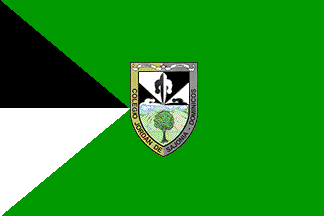 image by Ivan Sache, 3 January 2009
image by Ivan Sache, 3 January 2009
"Colegio Jordán de Sajonia" was recognized by the
Ministry of National Education on 18 May 1998 (Decree No. 3417).
as the legal successor of "Escuela Apostólica San Vicente
Ferrer", originally founded in the Colombian Marian town of
Chiquinquirá, Department of Boyacá, in the 1940s. On 29
September 1959, the new building of the institute, which had been
relocated in Bogotá in 1949, was inaugurated and the institute
was renamed after Blessed Jordan of Saxony (c. 1190-1237), second
Master General of the Dominican Order and first successor of St.
Dominic. The institute is one of the six "colegios"
ran by the Dominican Order, together with the
"Universidad Santo Tomás", in
Colombia (Province of San Luis Bertrán of the Order).
The flag of the institute, as shown graphically and described on
the website
of the institute, is green with a triangle horizontally
divided black-white placed along the hoist and
pointing to the coat of arms of the institute, which is,
apparently, placed in the middle of the flag.
Green represents virtue and hope. Black and white are the colours
of the Dominican Order.
Black, as absorbing light, represents interiorization and
appropriation of knowledge.
White, as the lack of colour and the plenitude of light,
represents truth revealed to mankind and enlightening it.
The coat of arms of the institute was designed by Friar Alberto
Epaminondas Ariza, who was in charge of the transfer of the
institute to its new site in the 1950s. The shield is
horizontally divided, on top a half Cross of Calatrava, which is
the coat of arms of the Dominican Order, on bottom a landscape
showing a green oak in front of green mountains surmounted by a
blue sky with three white clouds. The oak represents the firmness
of the education program of the college, expected to raise the
students up to mountains where they will challenge storms.
The shield is surmounted by a scroll bearing a star symbolizing
St. Dominic and the motto of the college, "STEMUS
SIMUL" ("Let us stand together", Isaiah 50.8),
adopted in 1954. The border is coloured or (dexter) and argent
(sinister) to symbolize the rich educationalist tradition of the
Dominican community. The black writing "COLEGIO JORDÁN DE
SAJONIA - DOMINICOS" was added to the border of the shield
in 1997.
Ivan Sache, 3 January 2009
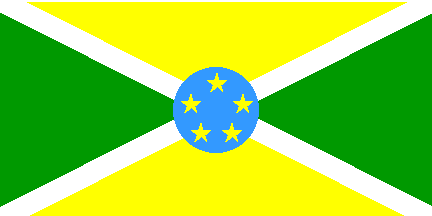 image by Ivan Sache, 24 November 2014
image by Ivan Sache, 24 November 2014
Institución Educativa Jorge Alberto Gómez Gómez (INEJAGO) is located
in Granada (Antioquia Department).
The institute is named for a former Mayor of Granada, Jorge Alberto
Gómez Gómez, who was awarded in 1997 the title of "Best Mayor in
Antioquia".
The flag of the institute is divided yellow-green by a white saltire.
In the middle is placed a blue disk charged with five yellow stars.
Source:
http://www.granada-antioquia.gov.co/index.php?option=com_content&view=article&id=434:ie-jorge-alberto-gomez-gomez&catid=99:nuestras-instituciones - Granada municipal website
Ivan Sache, 24 November 2014
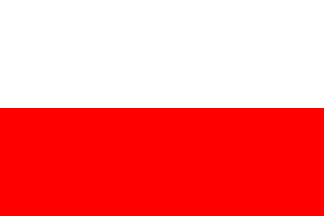 image by Ivan Sache, 1 January 2021
image by Ivan Sache, 1 January 2021
Colegio Jorge Ardila Duarte is located in La Concordia, Bucaramanga
(Santander).
The flag of Colegio Jorge Ardila Duarte is horizontally
divided white-red.
The two stripes express balance between science (use
of reasoning) and art (expression of emotion).
White also represents
deepness, transparency and kindness as attitudes generated by art for the
formation of a better human being.
Red represents art, glee, enthusiasm and
fervor, as the concrete expression of human sensibility.
http://www.jorgeardiladuarte.edu.co/index.php/page/item/19
Ivan Sache,
1 January 2021
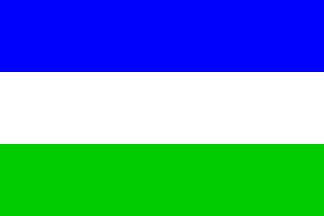 image by Ivan Sache, 12 July 2014
image by Ivan Sache, 12 July 2014
Colegio Integrado Jorge Isaac was established on 14 February 1972 in Diamante
I borough, part of the municipality of Bucaramanga (Santander Department), by
Isaac Salcedo Lizarazo (1925-2010) and Ernestina Sánchez de Salcedo.
The
flag of the institute is horizontally divided blue-white-light green. The blue
stripe represents the search for noble ideals. The white stripe is a symbol of
purity, limpidity, and beauty. The light green stripe is a symbol of hope.
http://www.coljorgeisaac.com/sitio/insignias.html - Institute's website
Ivan Sache, 12 July 2014
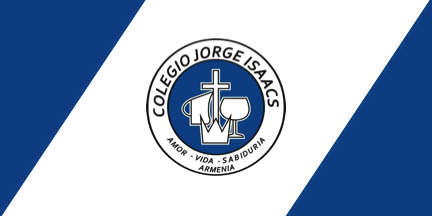 image by Ivan Sache, 23 September 2018
image by Ivan Sache, 23 September 2018
Colegio Jorge Isaacs was established on 7 February 1938 in Armenia (Quindio
Department) by Elizabeth Marstaller, as a section of Instituto Bíblico Bethel (Seminario
Bíblico de la Alianza de Colombia). The school is managed by the Christian and
Missionary Alliance (C&MA), an evangelical Christian denomination founded in
1887 in Canada by Reverend Albert Benjamin Simpson (1843-1919).
The flag
is diagonally divided blue-white-blue with the college's coat of arms in the
center. Blue is a symbol of excellence, highness, vision, triumph and valor.
White is a symbol of peace and mind straightforwardness.
The coat of arms
features the emblem of the Christian and Missionary Alliance.
http://colegiojorgeisaacs.com/nuestros-simbolos/
School website
The emblem of the C&MA represents the Fourfold Gospel. The pitcher symbolizes
Christ our Healer. It speaks of oil for divine life and physical healing (Isaiah
53:4-5). The cross typifies Jesus Christ our Saviour. He died on a cross for our
sins, and only through him can we be made right with God (John 3:16). The crown
stands for Christ our Coming King. He will come back to this earth and reign
forever (Acts 1:11). The laver illustrates Christ as our Sanctifier. The laver,
a large basin used in God's temple for washing, represents cleaning from sin by
the power of the Holy Spirit (1 Thessalonians 5:23-24).
https://www.cmacan.org/resources/logo
C&MA Canada website
Ivan Sache, 23 September 2018
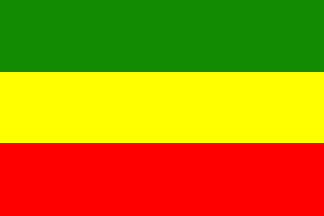 image by Ivan Sache, 10 January 2021
image by Ivan Sache, 10 January 2021
Colegio Jorge Eliécer Gaitán was established in Maripí (Boyaca) by Resolution
No. 407 issued in May 1976. It was succeeded by Institución Educativa Jorge
Eliecer Gaitan, established by Resolution No. 2,925 issued on 2 December 2008 as
the merger of 21 urban and rural schools (Concentración Urbana Mixta, Carlos
Rivadeneira, Portachuelo, Llano de Palmas, Santa Rita, El Coper, El Palmar, La
Batea, La Vega del Tigre, Alto de Las Cruces, Narapay, La Carrera, El Salto, San
Antonio Alto, San Antonio Bajo, Guayabal, Pan de Azúcar, Maripí Viejo, Tapias
and Boquerón).
The school is named for the politician Jorge Eliecer Gaitan
(1898-1948), President of the Chamber of Representatives (1923-1932) Mayor of
Bogotá (1936-1937), Minister of Education (1940-1941) and Ministry of Work,
Health and Social Planning (1942-1943). Gaitan was murdered in 1948 during the
campaign for the presidential election, which caused the people's revolt known
as Bogotazo and initiated the troubled period known as The Violence.
http://iejeg.edu.co/ubicacion.html
School website
Ivan Sache, 10 January 2021
 image by Ivan Sache, 15 November 2010
image by Ivan Sache, 15 November 2010
Colegio Jorge Isaacs is located in Soacha (Department of Cundinamarca). The
institute is named for the Colombian poet and novelist Jorge Isaacs (1837-1895),
mostly known for his romantic novel "Maria". The flag of Colegio Jorge Isaacs,
as shown graphically on the institute's blog, is horizontally divided
blue-white.
http://cjialexaykanchis.blogspot.com/2009/05/simbolos-cji.html
Ivan Sache, 15 November 2010
 image by Ivan Sache, 19 July 2014
image by Ivan Sache, 19 July 2014
Colegio Distrital Jorge Isaacs is located in the Simón Bolivar borough, part of the municipality of Barranquilla (Atlántico Department). The institute is named for the Colombian poet and novelist Jorge Isaacs (1837-1895), mostly known for his romantic novel "Maria".
The flag of the institute is horizontally divided white-light blue. White is
a symbol of peace. Blue represents the water that surrounds the coast and is the
source of life.
http://luissalavarria.wordpress.com/colegio-distrital-jorge-isaacs/ - Luis
C. Salavarria's blog
image by Ivan Sache, 19 July 2014
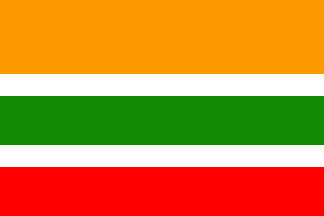 image by Ivan Sache and Tomislav Todorovic, 10 January 2021
image by Ivan Sache and Tomislav Todorovic, 10 January 2021
Instituto Nacional de Educación Media Jorge Isaacs is located in Cali.
The flag of INEM Jorge Isaacs is horizontally divided
orange-white-green-white-purple red. The orange stripe is twice wider than the
green or the red stripe. The white stripes are narrower, of the same width.
Orange is a symbol of glee, dynamism and enthusiasm.
Green is a symbol of
hope in the future, preservation of the planet and aspiration to triumph.
Red is a symbol of force, power and commitment to reach the proposed
objectives.
White is a symbol of purity, tranquility, harmony and peace.
https://m.exam-10.com/law/25008/index.html
Photos
https://www.facebook.com/INEMCALIOFICIAL/photos/bandera-del-inem/1833539956763655
https://www.facebook.com/INEMCALIOFICIAL/photos/1833540316763619
Ivan Sache,
10 January 2021
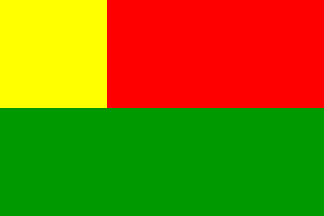 image by Ivan Sache, 9 January 2009
image by Ivan Sache, 9 January 2009
"Instituto Jorge Robledo" was founded in 1949 in
Medellín. The institute is named after the Spanish Marshal Jorge
Robledo (1500-1546), known as "The Conquistador of
Antioquia". The President of the Republic Àlvaro Uribe
Vélez and the cyclist Santiago Botero have studied in the
institute.
The flag of the institute, as shown graphically and described on
the website of
ADER ("Asociación de Robledistas"), is
horizontally divided red-green with a yellow square canton.
Red represents the youth's ardor and valor.
Green conveys self-confidence, represents the fecund daily work
and recalls the classic pennant of Antioquia.
Yellow represents purity and firmness required to reach the
objectives.
Ivan Sache, 9 January 2009
Current flag of the University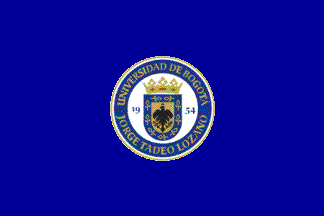 image by Ivan Sache, 3 December 2005
image by Ivan Sache, 3 December 2005
Current emblem of the University
.gif) image from the University
website
image from the University
website
Former, original flag of the University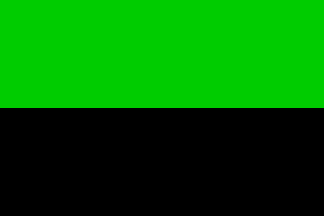 image by Ivan Sache, 3 December 2005
image by Ivan Sache, 3 December 2005
The Jorge Tadeo Lozano University of Bogotá
(Universidad de Bogotá Jorge Tadeo Lozano) was founded on 5
February 1954 by Joaquín Molano Campuzano, Javier Pulgar Vidal
and Jaime Forero Valdés. The main goal of the University was
"to continue on the cultural and scientific work initiated
during the Botanical Expedition in the Kingdom of New
Granada." This expedition (Expedición Botánica
del Nuevo Reino de Granada) took place in 1783.
Accordingly, the University is named after Jorge Tadeo Lozano
(1770-1816). Lozano, born in a noble family from Santafé de
Bogotá (today internationally known as Bogotá), studied
chemistry in the Royal Laboratory of Madrid (Spain) and was
appointed Professor of Chemistry in the Colegio de Nuestra Senora
del Rosario in Santa Fé. Lozano took part to the Botanical
Expedition as a zoologist. In 1801, he was visited in Santafé by
the famous naturalists Humboldt and Bonpland. Lozano was also a
patriot. He wrote in 1811 a proposal of liberal Constitution and
set up an alliance with Venezuela, which is considered as the
first attempt of pan-Americanism. In 1814, Lozano published with
José Ángel Manrique the struggle newspaper "El anteojo de
larga vista"; he was elected Representative of the Province
of Chocó at the General Congress gathered in Santafé. Lozano
was arrested and sentenced to death in 1816 with other patriots;
he was shot on 6 July 1816. One of the founders of the
University, Joaquín Molano, is a descendant of Joaquín Gómez
Hoyos, husband of María Tadea Lozano e Isasi, Lozano's widow.
The first faculties of the University, which is nicknamed
"la Tadeo", opened in 1955. The University increased
with time and more faculties were incorporated. In 1962, the
Faculty of Marine Sciences initiated teaching of Aquaculture and
Oceanography in Colombia. The bicentenary of the Botanical
Expedition was celebrated in 1983 with the structure of the
University into three academic areas recalling the goals of
the Expedition: Engineering and Natural Resources
(Agricultural Management, Marine Biology, Food Science, Agrology
and Geography), Law and Economics (Law, Management, Information
Systems, International Trade, Public Accounting, Economics,
Market, International Relations, Foreign Trade and Tourism) and
Arts, Design and Communication (Architecture, Interior Design,
Fine Arts, Social Communication, Graphic Design, Industrial and
Commercial Design). Some faculties have been relocated in
Cartagena and Santa Marta.
The flag of the University is blue with the emblem of the
University in the middle. This flag was adopted by the Board of
the University on 1 December 2001 (Decree #19). It superseded the
former, original flag of the University, which was horizontally
divided green-black.
The University used three successive emblems. The first, original
emblem shows a green star with the white letters UJTL, the
acronym of the University, supported by a stylized bird (?). This
emblem is based on the emblem of the Peruvian party APRA, itself based on the Halcón from
the local culture Chavin from Huantar. It recalls the strong
Indo-American feelings of APRA, shared by the founders of the
University.
The second emblem of the University was proposed by Dr. Fabio
Lozano y Lozano, President of the Board of the University and
member of the International Institute of Genealogy and Heraldry,
and approved by the Board on 13 June 1960. The shield is:
"El de Bogotá, teniendo en cuenta el nombre de la misma y
el hecho de haber sido fundada en esta ciudad". (The
[shield] of Bogotá, because of bearing the name of the city and
having been founded in the city). The graphical design of the
emblem was made by the artist César Pedraza, alumnus of the
Faculty of Geography of the University. The shield of the
University differs from the standard coat
of arms of Bogotá by its Spanishized shape and some further
details. The original shield of Santafé de Bogotá was granted
by Emperor Charles V for the whole Kingdom of New Granada, by
patented letters signed on 3 December 1548 in Valladolid:
"… por sus armas conocidad un escudo que en medio dél
haya una águila negra rampante entera, coronada de oro, que en
cada mano tenga una granada colorada en campo de oro, y por erla
unos ramos con granadas de oro en campo azul …". The
eagle (águila) symbolizes greatness and noble view; as portrayed
on the shield, it is an adaptation of Isobel the Catholic's
eagle. The shield is crowned by a Duke's coronet, as it is often
the case on the shield of Spanish cities.
The third, currently in use, emblem of the University was
proposed by Dr. Alfonso Velasco Rojas, Head of the Department of
Publishing and Corporate Emblematic of the University and
approved by the Board on 1 August 2000 (Decree #13). The
graphical design of the emblem was made by Felipe Duque Rueda.
The shield of the University is surrounded by a ring bearing the
name of the University and flanked by the year of foundation: 19
(left) 54 (right). The whole emblem is coloured in blue; the name
of the University is written below the emblem in black. The
representation of the shield has been improved compared with the
second version of the emblem of the University. The multicoloured
version of the emblem shall be used only in the official
documents of the University released by the Rectorate and the
General Secretariat. The flag of the University features that
coloured version of the emblem.
Source: Universidad
de Bogota Jorge Tadeo Lozano, located by Valentin Poposki.
Ivan Sache, 3 December 2005